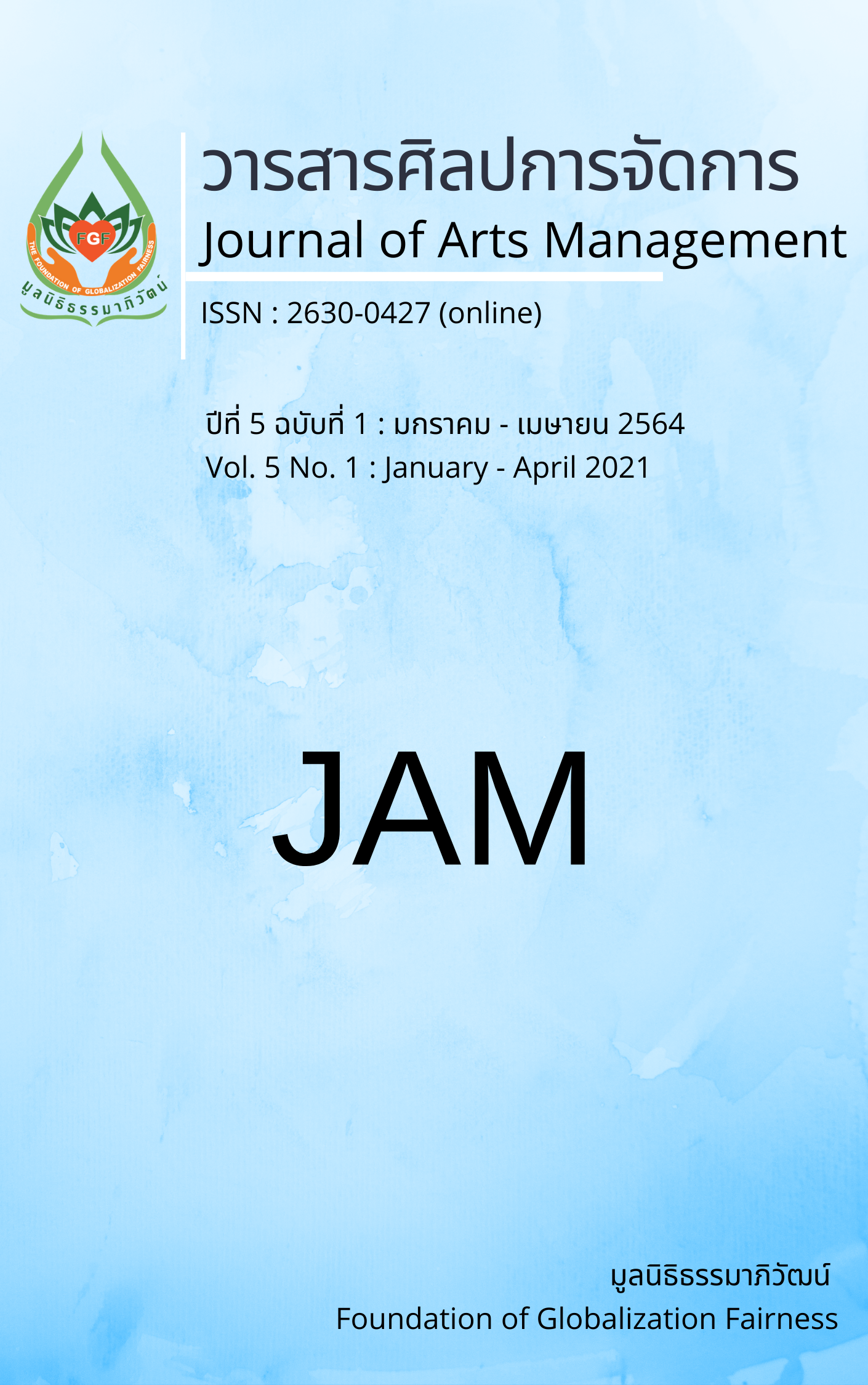ปัจจัยเชิงสาเหตุที่มีอิทธิพลต่อความตั้งใจเข้าชมสถานที่ท่องเที่ยวบนเพจ เฟซบุ๊กท่องเที่ยวซ้ำของนักท่องเที่ยวชาวไทย
Main Article Content
บทคัดย่อ
บทความนี้มีวัตถุประสงค์ 1) เพื่อพัฒนาและตรวจสอบความสอดคล้องของโมเดลความสัมพันธ์เชิงสาเหตุความตั้งใจเข้าชมสถานที่ท่องเที่ยวบนเพจเฟซบุ๊กท่องเที่ยวซ้ำของนักท่องเที่ยวชาวไทย 2) เพื่อศึกษาปัจจัยเชิงสาเหตุที่มีอิทธิพลต่อความตั้งใจเข้าชมสถานที่ท่องเที่ยวบนเพจเฟซบุ๊กท่องเที่ยวซ้ำของนักท่องเที่ยวชาวไทย การวิจัยครั้งนี้เป็นการวิจัยเชิงปริมาณ กลุ่มตัวอย่าง ได้แก่ คนไทยที่เคยเข้าชมสถานที่ท่องเที่ยวบนเพจเฟซบุ๊กท่องเที่ยวอย่างน้อย 2 ครั้งขึ้นไป จำนวน 260 คน ได้มาจากการเลือกตัวอย่างแบบโควต้า เครื่องมือที่ใช้เก็บรวบรวมข้อมูล ได้แก่ แบบสอบถามออนไลน์ สถิติที่ใช้ในการวิเคราะห์ข้อมูล ได้แก่ ความถี่ ร้อยละ และโมเดลสมการโครงสร้าง
ผลการวิจัยพบว่า โมเดลความสัมพันธ์เชิงสาเหตุที่พัฒนาขึ้น ประกอบด้วย 5 ด้าน ได้แก่ 1) ด้านแรงจูงใจ 2) ด้านคุณภาพเนื้อหา 3) ด้านการรับรู้คุณค่า 4) ด้านความพึงพอใจ และ 5) ด้านความตั้งใจเยี่ยมชมซ้ำ และสอดคล้องกับข้อมูลเชิงประจักษ์เป็นอย่างดี โดยพิจารณาจากค่าสถิติไค-สแควร์ (c2) = 258.73, ค่า CMIN/df = 1.08, ค่าองศาอิสระ (df) = 238, ค่า GFI = 0.93, ค่า AGFI = 0.90, ค่า SRMR = 0.04, ค่า RMSEA = 0.02 ค่าสัมประสิทธิ์การพยากรณ์ = 0.91 และตัวแปรที่มีอิทธิพลต่อความตั้งใจเข้าชมสถานที่ท่องเที่ยวบนเพจเฟซบุ๊กท่องเที่ยวซ้ำ คือ ปัจจัยด้านแรงจูงใจ ปัจจัยด้านความพึงพอใจ ปัจจัยด้านคุณภาพเนื้อหา และปัจจัยด้านการรับรู้คุณค่า ตามลำดับ ผู้ดูแลเพจเฟซบุ๊กท่องเที่ยวสามารถนำไปใช้ประโยชน์ในการสร้างเนื้อหาให้เหมาะสมกับผู้เข้ามาชมเพจเฟซบุ๊กท่องเที่ยว อันเป็นผลให้เกิดความตั้งใจเข้าชมสถานที่ท่องเที่ยวบนเพจเฟซบุ๊กท่องเที่ยวซ้ำในอนาคต
Article Details
ทัศนะและความคิดเห็นที่ปรากฏในบทความในวารสารศิลปการจัดการ ถือเป็นความรับผิดชอบของผู้เขียนบทความนั้น และไม่ถือเป็นทัศนะและความรับผิดชอบของกองบรรณาธิการ ยินยอมว่าบทความเป็นลิขสิทธิ์ของวารสารศิลปการจัดการ
เอกสารอ้างอิง
กริช แรงสูงเนิน. (2554). การวิเคราะห์ปัจจัยด้วย SPSS และ AMOS เพื่อการวิจัย. กรุงเทพฯ: ซีเอ็ด ยูเคชั่น.
จิราภา สุวรรณรัษฎากร, อารีวรรณ สุขวิลัย, มยุรี ศรีกุลวงศ์ และ อรรถศิษฐ์ พัฒนะศิริ. (2561). การรับรู้ภาพถ่ายสถานที่ท่องเที่ยวในเฟซบุ๊กมีอิทธิพลต่อพฤติกรรมการตัดสินใจท่องเที่ยวเมืองเลห์ ลาดัก ประเทศอินเดีย. วารสารวิชาการนวัตกรรมสื่อสารสังคม, 6(1), 8–13.
ชไมพร กาญจนกิจสกุล. (2555). ระเบียบวิธีวิจัยทางสังคมศาสตร์. ตาก: โพรเจ็คท์ไฟฟ์-โฟว์.
ฐิติมา รัตนพงษ์. (2557). ผลกระทบของความผูกพันและความพึงพอใจที่มีต่อแนวโน้มการกลับมาเที่ยวซ้ำยังแหล่งท่องเที่ยวในจังหวัดนครศรีธรรมราช (วิทยานิพนธ์บริหารธุรกิจมหาบัณฑิต). มหาวิทยาลัยสงขลานครินทร์.
นงลักษณ์ วิรัชชัย. (2542). โมเดลลิสเรล: สถิติวิเคราะห์สำหรับการวิจัย. (พิมพ์ครั้งที่3). กรุงเทพมหานคร: โรงพิมพ์แห่งจุฬาลงกรณ์มหาวิทยาลัย.
รัชต์ภาค พงษ์สิทธิศักดิ์ และสุมามาลย์ ปานคำ. (2562). รูปแบบความสัมพันธ์เชิงสาเหตุความตั้งใจในการท่องเที่ยวของผู้ติดตามแฟนเพจเฟซบุ๊กรีวิวการท่องเที่ยวในประเทศไทย. วารสาร มจร พุทธปัญญาปริทรรศน์, 5(2), 163–173.
รัญชิดา สังขดวง และธนินทร์ สังขดวง. (2559). ความตั้งใจในการกลับมาเที่ยวซ้ำของนักท่องเที่ยวมาเลเซียภายใต้สถานการณ์ความไม่สงบพื้นที่ด่านชายแดนไทย อำเภอเบตง จังหวัดยะลา. วารสารวิจัยมหาวิทยาลัยเทคโนโลยีราชมงคลศรีวิชัย, 8(2), 261-276.
รัตนาภรณ์ ศรีม่วง. (2559). การศึกษาระดับความพึงพอใจของนักท่องเที่ยวที่มีต่อสถานที่ท่องเที่ยว หุ่นเหล็กโคราช ตำบลมะเกลือใหม่ อำเภอสูงเนิน จังหวัดนครราชสีมา (รายงานวิจัย). มหาวิทยาลัยราชภัฏนครราชสีมา.
รัมภ์รดา สารอูป และ มณฑกาณติ ชุบชูวงศ์. (2564). การศึกษาความพึงพอใจต่อแหล่งท่องเที่ยวที่ส่งผลต่อการกลับมาเยือนซ้ำ ณ บ่อน้ำพุร้อนฝาง อุทยานแห่งชาติดอยฟ้าห่มปก จังหวัดเชียงใหม่. วารสารวิชาการวิทยาลัยสันตพล, 7(1), 136-146.
วรรณวีร์ บุญคุ้ม. (2560). แรงจูงใจในการมาเยือนวัดสำคัญในจังหวัดเพชรบุรีและการรับรู้การที่มีอิทธิพลต่อการกลับมาเยือนซ้ำของนักท่องเที่ยวชาวไทย (วิทยานิพนธ์ศิลปศาสตรมหาบัณฑิต). มหาวิทยาลัยธุรกิจบัณฑิตย์.
Cronin, J. J., Brady, M. K. & Hult, G. T. M. (2000). Assessing the effects of quality, value, and customer satisfaction on consumer behavioral intentions in service environments. Journal of Retailing, 76(2), 193-218.
Hair, J. F., Black, W. C., Babin, B. J. & Anderson, R. E. (2009). Multivariate data analysis. (7th ed.). New Jersey: Pearson Prentice Hall.
Hellier, P. K., Ganesan, G. M., Carr, R. A. & Rickard, G. A. (2003). Customer repurchase intention: A general structural equation model. European Journal of Marketing, 37(11-12), 1762-1800.
Hoelter, D. R. (1983). The analysis of covariance structures: Goodness of Fit indices. Journal of Socillogical Methods and Research, 11(3), 325-344.
Gronroos, C. (1990). Relationship approach to marketing in service contexts: The marketing and organizational behavior interface. Journal of Business Research, 20(1), 3–11.
Johnson, M. D., Anderson, E. W. & Fornell, C. (1995). Rational and Adaptive Performance Expectations in a Customer Satisfaction Framework. Journal of Consumer Research, 695-707.
Kline, R. B. (2011). Principles and practice of structural equation modeling. (3rd ed.). New York: The Guilford Press.
Lee, J. C. (2010). An investigation of the relationship between service quality, transaction specific satisfaction, and overall satisfaction in predicting golfers' revisit intentions. Unpublished doctoral dissertation, Clemson University, South Carolin.
Lewis, R. C. & Blooms, B. H. (1983). The marketing aspects of service quality. American Marketing Association, Chicago.
Pearce, P. L. & Lee, U. (2005). Developing the travel career approach to tourist motivation. Journal of Travel Research, 43(3), 226-237.
Pizam, A. & Mansfeld, Y. (1999). Consumer Behavior in Travel and Tourism. Haworth Hospitality Press. Modern Economy.
Shakoori, A. & Hosseini, M. (2019). An examination of the effects of motivation on visitors' loyalty: case study of the Golestan Palace, Tehran. Tourism Management Perspectives, 32(1), 1- 13.
Triantafillidou, A. & Siomkos, G. (2014). Consumption experience outcomes: Satisfaction, nostalgia intensity, word-of-mouth communication and behavioral intentions. Journal of Consumer Marketing, 31(6/7), 526-540.
Wilkinson A. J. (2001). Unweaving Leaving: the use of models in the management of employee turnover. International Journal of Management Reviews, 3(3), 219-244.


